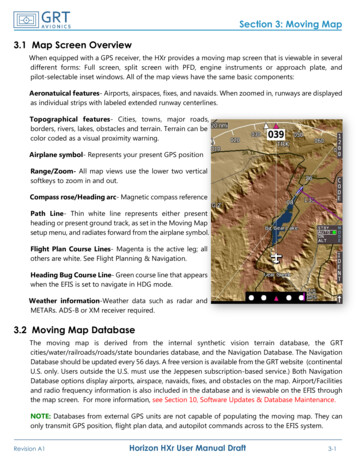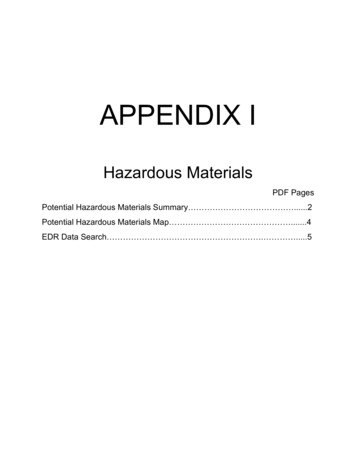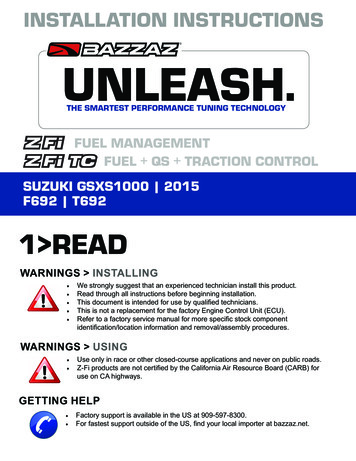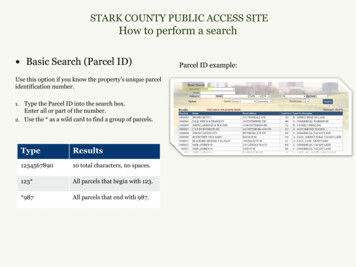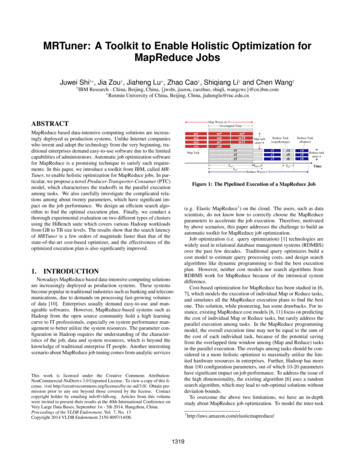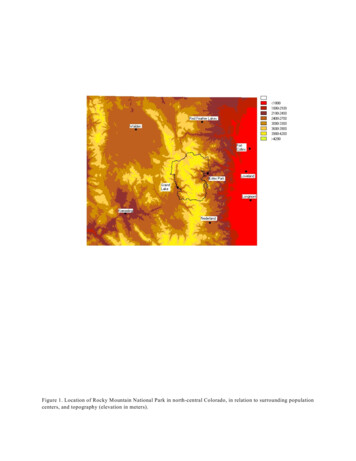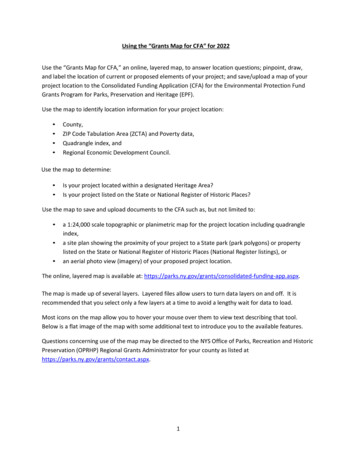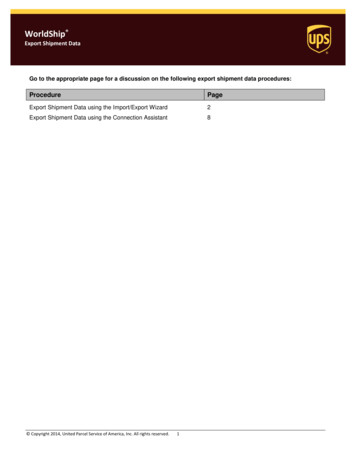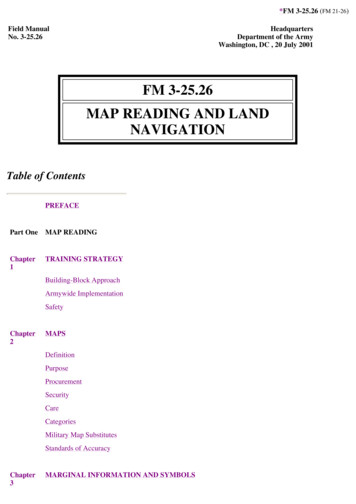
Transcription
*FM 3-25.26 (FM 21-26)Field ManualNo. 3-25.26HeadquartersDepartment of the ArmyWashington, DC , 20 July 2001FM 3-25.26MAP READING AND LANDNAVIGATIONTable of ContentsPREFACEPart OneMAP READINGChapter1TRAINING STRATEGYBuilding-Block ApproachArmywide rocurementSecurityCareCategoriesMilitary Map SubstitutesStandards of AccuracyChapter3MARGINAL INFORMATION AND SYMBOLS
Marginal Information on a Military MapAdditional NotesTopographic Map SymbolsMilitary SymbolsColors Used on a Military MapChapter4GRIDSReference SystemGeographic CoordinatesMilitary GridsUnited States Army Military Grid Reference SystemLocate a Point Using Grid CoordinatesLocate a Point Using the US Army Military Grid Reference SystemGrid Reference BoxOther Grid SystemsProtection of Map Coordinates and LocationsChapter5SCALE AND DISTANCERepresentative FractionGraphic (Bar) ScalesOther MethodsChapter6DIRECTIONMethods of Expressing DirectionBase LinesAzimuthsGrid AzimuthsProtractorDeclination DiagramIntersectionResectionModified ResectionPolar Coordinates
Chapter7OVERLAYSPurposeMap OverlayAerial Photograph OverlayChapter8AERIAL PHOTOGRAPHSComparison With MapsTypesTypes of FilmNumbering and Titling InformationScale DeterminationIndexingOrienting of PhotographPoint Designation GridIdentification of Photograph FeaturesStereovisionPart Two LAND NAVIGATIONChapter9NAVIGATION EQUIPMENT AND METHODSTypes of CompassesLensatic CompassCompass HandlingUsing a CompassField-Expedient MethodsGlobal Positioning SystemChapter10ELEVATION AND RELIEFDefinitionsMethods of Depicting ReliefContour IntervalsTypes of SlopesPercentage of SlopeTerrain Features
Interpretation of Terrain FeaturesProfilesChapter11TERRAIN ASSOCIATIONOrienting the MapLocationsTerrain Association UsageTactical ConsiderationsMovement and Route SelectionNavigation MethodsNight NavigationChapter12MOUNTED LAND NAVIGATIONPrinciplesNavigator's DutiesMovementTerrain Association NavigationDead Reckoning NavigationStabilized Turret Alignment NavigationCombination NavigationChapter13NAVIGATION IN DIFFERENT TYPES OF TERRAINDesert TerrainMountain TerrainJungle TerrainArctic TerrainUrban AreasChapter14UNIT SUSTAINMENTSet Up a Sustainment ProgramSet Up a Train-the-Trainer ProgramSet Up a Land Navigation CourseAppendix FIELD SKETCHING
AAppendix MAP FOLDING TECHNIQUESBAppendix UNITS OF MEASURE AND CONVERSION FACTORSCAppendix JOINT OPERATIONS GRAPHICSDAppendix EXPORTABLE TRAINING MATERIALEAppendix ORIENTEERINGFAppendix M2 COMPASSGAppendix ADDITIONAL AIDSHAppendix FOREIGN MAPSIAppendix GLOBAL POSITIONING SYSTEMJAppendix PRECISION LIGHTWEIGHT GLOBAL POSITIONING SYSTEM ION RESTRICTION: Approved for public release: distribution is unlimited.*This publication FM 3-25.26 supersedes FM 21-26, 7 May 1993.
PrefaceThe purpose of this field manual is to provide a standardized source document for Armywidereference on map reading and land navigation. This manual applies to every soldier in the Armyregardless of service branch, MOS, or rank. This manual also contains both doctrine and training guidanceon these subjects. Part One addresses map reading and Part Two, land navigation. The appendixes includea list of exportable training materials, a matrix of land navigation tasks, an introduction to orienteering,and a discussion of several devices that can assist the soldier in land navigation.The proponent of this publication is the US Army Infantry School. Submit changes to thispublication on DA Form 2028 (Recommended Changes to Publications and Blank Forms) directly to—CommandantUS Army Infantry SchoolATTN: ATSH-IN-S3Fort Benning, GA 31905-5596.Lusanoh@benning.army.milUnless this publication states otherwise, masculine nouns and pronouns do not refer exclusively to men.
PART ONEMAP READINGCHAPTER 1TRAINING STRATEGYThis manual is in response to an Armywide need for a new map reading and land navigation trainingstrategy based on updated doctrine. This chapter describes and illustrates this approach to teaching theseskills.1-1. BUILDING-BLOCK APPROACHInstitution courses are designed to prepare the soldier for a more advanced duty position in his unit. The criticalsoldiering skills of move, shoot, and communicate must be trained, practiced, and sustained at every level in theschools as well as in the unit. The map reading and land navigation skills taught at each level are critical to thesoldiering skills of the duty position for which he is being school-trained. Therefore, they are also a prerequisite for acritical skill at a more advanced level.a. A soldier completing initial-entry training must be prepared to become a team member. He must beproficient in the basic map reading and dead reckoning skills.b. After completing the Primary Leadership Development Course (PLDC), a soldier should be ready to be ateam leader. This duty position requires expertise in the skills of map reading, dead reckoning, and terrainassociation.c. A soldier completing the Basic NCO Course (BNCOC) has been trained for the squad leader position. Mapreading and land navigation at skill level 3 requires development of problem-solving skills; for example, routeselection and squad tactical movement.d. At skill level 4, the soldier completing the Advanced NCO Course (ANCOC) is prepared to assume the dutyposition of platoon sergeant or operations NCO. Planning tactical movements, developing unit sustainment, andmaking decisions are the important land navigation skills at this level.e. Officers follow similar progression. A new second lieutenant must have mastered map reading and landnavigation skills, and have an aptitude for dead reckoning and terrain association.(1) After completing the Officer Basic Course, the officer must be prepared to assume the duties andresponsibilities of a platoon leader. He is required to execute the orders and operations of his commander.Map reading and land navigation at this level require development of the problem-solving skills of routeselection and tactical movement.(2) After completing the Officer Advanced Course, the officer is prepared to assume the duties andresponsibilities of a company commander or primary staff officer. The commander must plan and executeoperations with full consideration to all aspects of navigation. The staff officer must recommendbattlefield placement of all administrative, logistical, and personnel resources. These recommendationscannot be tactically sound unless the estimate process includes a detailed analysis of the area ofoperations. This ability requires expertise in all map reading and navigation skills to include the use ofnonmilitary maps, aerial photographs, and terrain analysis with respect to both friendly and enemy forces.The commander/staff officer must plan and execute a program to develop the unit's train-the-trainerprogram for land navigation.f. A program of demonstrated proficiency of all the preceding skill levels to the specified conditions andstandards is a prerequisite to the successful implementation of a building-block training approach. Thisapproach reflects duty position responsibilities in map reading and land navigation. An understanding of thefundamental techniques of dead reckoning or field-expedient methods is a basic survival skill that each soldiermust develop at the initial-entry level. This skill provides a support foundation for more interpretive analysis atintermediate skill levels 2 and 3, with final progression to level 4. Mastery of all map reading and land
navigation tasks required in previous duty positions is essential for the sequential development of increasinglydifficult abilities. This building-block approach is supported by scope statements. It is part of the trainingdoctrine at each level in the institutional training environment of each course.g. Exportable training and instructor support/certification packages are being developed based upon theupdated map reading and land navigation field manual. Innovative training devices and materials are beingdeveloped for use in the institution, ROTC regions, and the field. (See Appendixes E and H. )1-2. ARMYWIDE IMPLEMENTATIONA mandatory core of critical map reading and land navigation tasks and a list of electives will be provided to eachTRADOC service school and FORSCOM professional development school. Standardization is achieved through themandatory core. Exportable training material is made available to support Armywide implementation.1-3. SAFETYUnit leaders plan to brief and enforce all safety regulations established by local range control. They coordinate themode of evacuation of casualties through the appropriate channels. They review all installation safety regulations. Unitleaders must complete a thorough terrain reconnaissance before using an area for land navigation training. Theyshould look for dangerous terrain, heavy trafficked roads, water obstacles, wildlife, and training debris.
CHAPTER 2MAPSCartography is the art and science of expressing the known physical features of the earth graphically bymaps and charts. No one knows who drew, molded, laced together, or scratched out in the dirt the firstmap. But a study of history reveals that the most pressing demands for accuracy and detail in mappinghave come as the result of military needs. Today, the complexities of tactical operations and deploymentof troops are such that it is essential for all soldiers to be able to read and interpret their maps in order tomove quickly and effectively on the battlefield. This chapter includes the definition and purpose of a mapand describes map security, types, categories, and scales.2-1. DEFINITIONA map is a graphic representation of a portion of the earth's surface drawn to scale, as seen from above. It uses colors,symbols, and labels to represent features found on the ground. The ideal representation would be realized if everyfeature of the area being mapped could be shown in true shape. Obviously this is impossible, and an attempt to ploteach feature true to scale would result in a product impossible to read even with the aid of a magnifying glass.a. Therefore, to be understandable, features must be represented by conventional signs and symbols. To belegible, many of these must be exaggerated in size, often far beyond the actual ground limits of the featurerepresented. On a 1:250,000 scale map, the prescribed symbol for a building covers an area about 500 feetsquare on the ground; a road symbol is equivalent to a road about 520 feet wide on the ground; the symbol for asingle-track railroad (the length of a cross-tie) is equivalent to a railroad cross-tie about 1,000 feet on theground.b. The portrayal of many features requires similar exaggeration. Therefore, the selection of features to beshown, as well as their portrayal, is in accord with the guidance established by the Defense Mapping Agency.2-2. PURPOSEA map provides information on the existence, the location of, and the distance between ground features, such aspopulated places and routes of travel and communication. It also indicates variations in terrain, heights of naturalfeatures, and the extent of vegetation cover. With our military forces dispersed throughout the world, it is necessary torely on maps to provide information to our combat elements and to resolve logistical operations far from our shores.Soldiers and materials must be transported, stored, and placed into operation at the proper time and place. Much of thisplanning must be done by using maps. Therefore, any operation requires a supply of maps; however, the finest mapsavailable are worthless unless the map user knows how to read them.2-3. PROCUREMENTMost military units are authorized a basic load of maps. Local command supplements to AR 115-11 provide tables ofinitial allowances for maps. Map requisitions and distributions are accomplished through the Defense MappingAgency Hydrographic and Topographic Center's Office of Distribution and Services. In the division, however, mapsare a responsibility of the G2 section.a. To order a map, refer to the DMA catalog located at your S2/G2 shop. Part 3 of this catalog, TopographicMaps, has five volumes. Using the delineated map index, find the map or maps you want based upon thelocation of the nearest city. With this information, order maps using the following forms:(1) Standard Form 344. It can be typed or handwritten; it is used for mailing or over-the-counter service.(2) Department of Defense Form 1348. Same as SF 344. You can order copies of only one map sheet oneach form.(3) Department of Defense Form 1348M. This is a punch card form for AUDODIN ordering.(4) Department of Defense Form 173. This is a message form to be used for urgent ordering.
With the exception of the message form (DD 173), the numbered sections of all forms are the same. Forexample: In block 1, if you are in CONUS, enter "AOD," if you are overseas, enter "AO4. " In block 2, use oneof the following codes for your location.LOCATION NUSHM8Your supply section will help you complete the rest of the form.b. Stock numbers are also listed in map catalogs, which are available at division and higher levels andoccasionally in smaller units. A map catalog consists of small-scale maps upon which the outlines of theindividual map sheets of a series have been delineated. Another document that is an aid to the map user is thegazetteer. A gazetteer lists all the names appearing on a map series of a geographical area, a designation thatidentifies what is located at that place name, a grid reference, a sheet number of the map upon which the nameappeared, and the latitude and longitude of the named features. Gazetteers are prepared for maps of foreignareas only.2-4. SECURITYAll maps should be considered as documents that require special handling. If a map falls into unauthorized hands, itcould easily endanger military operations by providing information of friendly plans or areas of interest to the enemy.Even more important would be a map on which the movements or positions of friendly soldiers were marked. It ispossible, even though the markings on a map have been erased, to determine some of the erased information. Mapsare documents that must not fall into unauthorized hands.a. If a map is no longer needed, it must be turned in to the proper authority. If a map is in danger of beingcaptured, it must be destroyed. The best method of destruction is by burning it and scattering the ashes. Ifburning is not possible, the map can be torn into small pieces and scattered over a wide area.b. Maps of some areas of the world are subject to third party limitations. These are agreements that permit theUnited States to make and use maps of another country provided these maps are not released to any third partywithout permission of the country concerned. Such maps require special handling.c. Some maps may be classified and must be handled and cared for in accordance with AR 380-5 and, ifapplicable, other local security directives.2-5. CAREMaps are documents printed on paper and require protection from water, mud, and tearing. Whenever possible, a mapshould be carried in a waterproof case, in a pocket, or in some other place where it is handy for use but still protected.a. Care must also be taken when using a map since it may have to last a long time. If it becomes necessary tomark a map, the use of a pencil is recommended. Use light lines so they may be erased easily without smearingand smudging, or leaving marks that may cause confusion later. If the map margins must be trimmed for anyreason, it is essential to note any marginal information that may be needed later, such as grid data and magneticdeclination.b. Special care should be taken of a map that is being used in a tactical mission, especially in small units; the
mission may depend on that map. All members of such units should be familiar with the map's location at alltimes.c. Appendix B shows two ways of folding a map.2-6. CATEGORIESThe DMA's mission is to provide mapping, charting, and all geodesy support to the armed forces and all other nationalsecurity operations. DMA produces four categories of products and services: hydrographic, topographic, aeronautical,and missile and targeting. Military maps are categorized by scale and type.a. Scale. Because a map is a graphic representation of a portion of the earth's surface drawn to scale as seenfrom above, it is important to know what mathematical scale has been used. You must know this to determineground distances between objects or locations on the map, the size of the area covered, and how the scale mayaffect the amount of detail being shown. The mathematical scale of a map is the ratio or fraction between thedistance on a map and the corresponding distance on the surface of the earth. Scale is reported as arepresentative fraction with the map distance as the numerator and the ground distance as the denominator.Representative fraction (scale) map distance——————————ground distanceAs the denominator of the representative fraction gets larger and the ratio gets smaller, the scale of the mapdecreases. Defense Mapping Agency maps are classified by scale into three categories. They are small-,medium-, and large-scale maps (Figure 2-1). The terms "small scale," "medium scale," and "large scale"may be confusing when read in conjunction with the number. However, if the number is viewed as a fraction, itquickly becomes apparent that 1:600,000 of something is smaller than 1:75,000 of the same thing. Therefore,the larger the number after 1:, the smaller the scale of the map.Figure 2-1. Scale classifications.(1) Small. Those maps with scales of 1:1,000,000 and smaller are used for general planning and forstrategic studies (bottom map in Figure 2-1). The standard small-scale map is 1:1,000,000. This mapcovers a very large land area at the expense of detail.(2) Medium. Those maps with scales larger than 1:1,000,000 but smaller than 1:75,000 are used foroperational planning (center map in Figure 2-1). They contain a moderate amount of detail, but terrainanalysis is best done with the large-scale maps described below. The standard medium-scale map is1:250,000. Medium scale maps of 1:100,000 are also frequently encountered.(3) Large. Those maps with scales of 1:75,000 and larger are used for tactical, administrative, and
logistical planning (top map in Figure 2-1). These are the maps that you as a soldier or junior leader aremost likely to encounter. The standard large-scale map is 1:50,000; however, many areas have beenmapped at a scale of 1:25,000.b. Types. The map of choice for land navigators is the 1:50,000-scale military topographic map. It isimportant, however, that you know how to use the many other products available from the DMA as well. Whenoperating in foreign places, you may discover that DMA map products have not yet been produced to coveryour particular area of operations, or they may not be available to your unit when you require them. Therefore,you must be prepared to use maps produced by foreign governments that may or may not meet the standards foraccuracy set by DMA. These maps often use symbols that resemble those found on DMA maps but which havecompletely different meanings. There may be other times when you must operate with the only map you canobtain. This might be a commercially produced map run off on a copy machine at higher headquarters. InGrenada, many of our troops used a British tourist map.(1) Planimetric Map. This is a map that presents only the horizontal positions for the featuresrepresented. It is distinguished from a topographic map by the omission of relief, normally represented bycontour lines. Sometimes, it is called a line map.(2) Topographic Map. This is a map that portrays terrain features in a measurable way (usually throughuse of contour lines), as well as the horizontal positions of the features represented. The vertical positions,or relief, are normally represented by contour lines on military topographic maps. On maps showingrelief, the elevations and contours are measured from a specific vertical datum plane, usually mean sealevel. Figure 3-1 shows a typical topographic map.(3) Photomap. This is a reproduction of an aerial photograph upon which grid lines, marginal data, placenames, route numbers, important elevations, boundaries, and approximate scale and direction have beenadded. (See Chapter 8. )(4) Joint Operations Graphics. These maps are based on the format of standard 1:250,000 medium-scalemilitary topographic maps, but they contain additional information needed in joint air-ground operations(Figure 2-2). Along the north and east edges of the graphic, detail is extended beyond the standard mapsheet to provide overlap with adjacent sheets. These maps are produced both in ground and air formats.Each version is identified in the lower margin as either Joint Operations Graphic (Air) or Joint OperationsGraphic (Ground). The topographic information is identical on both, but the ground version showselevations and contour in meters and the air version shows them in feet. Layer (elevation) tinting andrelief shading are added as an aid to interpolating relief. Both versions emphasize airlanding facilities(shown in purple), but the air version has additional symbols to identify aids and obstructions to airnavigation. (See Appendix D for additional information. )
Figure 2-2. Joint operations graphic (air).(5) Photomosaic. This is an assembly of aerial photographs that is commonly called a mosaic intopographic usage. Mosaics are useful when time does not permit the compilation of a more accurate map.The accuracy of a mosaic depends on the method employed in its preparation and may vary from simply agood pictorial effect of the ground to that of a planimetric map.(6) Terrain Model. This is a scale model of the terrain showing features, and in large-scale modelsshowing industrial and cultural shapes. It provides a means for visualizing the terrain for planning orindoctrination purposes and for briefing on assault landings.(7) Military City Map. This is a topographic map (usually at 1:12,550 scale, sometimes up to 1:5,000),showing the details of a city. It delineates streets and shows street names, important buildings, and otherelements of the urban landscape important to navigation and military operations in urban terrain. Thescale of a military city map depends on the importance and size of the city, density of detail, and availableintelligence information.(8) Special Maps. These are maps for special purposes, such as trafficability, communications, andassault maps. They are usually in the form of an overprint in the scales smaller than 1:100,000 but largerthan 1:1,000,000. A special purpose map is one that has been designed or modified to give informationnot covered on a standard map. The wide range of subjects that could be covered under the heading ofspecial purpose maps prohibits, within the scope of this manual, more than a brief mention of a fewimportant ones. Some of the subjects covered are:zTerrain features.zDrainage characteristics.zVegetation.
zClimate.zCoasts and landing beaches.zRoads and bridges.zRailroads.zAirfields.zUrban areas.zElectric power.zFuels.zSurface water resources.zGround water resources.zNatural construction materials.zCross-country movements.zSuitability for airfield construction.zAirborne operations.2-7. MILITARY MAP SUBSTITUTESIf military maps are not available, use substitute maps. The substitute maps can range from foreign military orcommercial maps to field sketches. The DMA can provide black and white reproductions of many foreign maps andcan produce its own maps based upon intelligence.a. Foreign Maps. These are maps that have been compiled by nations other than our own. When these must beused, the marginal information and grids are changed to conform to our standards if time permits. The scalesmay differ from our maps, but they do express the ratio of map distance to ground distance and can be used inthe same way. The legend must be used since the map symbols almost always differ from ours. Because theaccuracy of foreign maps varies considerably, they are usually evaluated in regard to established accuracystandards before they are issued to our troops. (See Appendix I for additional information. )b. Atlases. These are collections of maps of regions, countries, continents, or the world. Such maps areaccurate only to a degree and can be used for general information only.c. Geographic Maps. These maps give an overall idea of the mapped area in relation to climate, population,relief, vegetation, and hydrography. They also show general location of major urban areas.d. Tourist Road Maps. These are maps of a region in which the main means of transportation and areas ofinterest are shown. Some of these maps show secondary networks of roads, historic sites, museums, and beachesin detail. They may contain road and time distance between points. Careful consideration should be exercisedabout the scale when using these maps.e. City/Utility Maps. These are maps of urban areas showing streets, water ducts, electricity and telephonelines, and sewers.f. Field Sketches. These are preliminary drawings of an area or piece of terrain. (See Appendix A.)g. Aerial Photographs. These can be used as map supplements or substitutes to help you analyze the terrain,plan your route, or guide your movement. (See Chapter 8 for additional information).
2-8. STANDARDS OF ACCURACYAccuracy is the degree of conformity with which horizontal positions and vertical values are represented on a map inrelation to an established standard. This standard is determined by the DMA based on user requirements. A map canbe considered to meet accuracy requirement standards unless otherwise specified in the marginal information.
CHAPTER 3MARGINAL INFORMATION AND SYMBOLSA map could be compared to any piece of equipment, in that before it is placed into operation the usermust read the instructions. It is important that you, as a soldier, know how to read these instructions. Themost logical place to begin is the marginal information and symbols, where useful information tellingabout the map is located and explained. All maps are not the same, so it becomes necessary every time adifferent map is used to examine the marginal information carefully.3-1. MARGINAL INFORMATION ON A MILITARY MAPFigure 3-1 shows a reduced version of a large-scale topographic map. The circled numbers indicate the items ofmarginal information that the map user needs to know. These circled numbers correspond to the following listeditems.a. Sheet Name (1). The sheet name is found in bold print at the center of the top and in the lower left area ofthe map margin. A map is generally named for the settlement contained within the area covered by the sheet, orfor the largest natural feature located within the area at the time the map was drawn.b. Sheet Number (2). The sheet number is found in bold print in both the upper right and lower left areas ofthe margin, and in the center box of the adjoining sheets diagram, which is found in the lower right margin. It isused as a reference number to link specific maps to overlays, operations orders, and plans. For maps at1:100,000 scale and larger, sheet numbers are based on an arbitrary system that makes possible the readyorientation of maps at scales of 1:100,000, 1:50,000, and 1:25,000.c. Series Name (3). The map series name is found in the same bold print as the sheet number in the upper leftcorner of the margin. The name given to the series is generally that of a major political subdivision, such as astate within the United States or a European nation. A map series usually includes a group of similar maps at thesame scale and on the same sheet lines or format designed to cover a particular geographic area. It may also be agroup of maps that serve a common purpose, such as the military city maps.d. Scale (4). The scale is found both in the upper left margin after the series name, and in the center of thelower margin. The scale note is a representative fraction that gives the ratio of a map distance to thecorresponding distance on the earth's surface. For example, the scale note 1:50,000 indicates that one unit ofmeasure on the map equals 50,000 units of the same measure on the ground.e. Series Number (5). The series number is found in both the upper right margin and the lower left margin. Itis a sequence reference expressed either as a four-digit numeral (1125) or as a letter, followed by a three- orfour-digit numeral (M661; T7110).f. Edition Number (6). The edition number is found in bold print in the upper right area of the top margin andthe lower left area of the bottom margin. Editions are numbered consecutively; therefore, if you have more thanone edition, the highest numbered sheet is the most recent. Most military maps are now published by the DMA,but older editions of maps may have been produced by the US Army Map Service. Still others may have beendrawn, at least in part, by the US Army Corps of Engineers, the US Geological Survey, or other agenciesaffiliated or not with the United States or allied governments. The credit line, telling who produced the map, isjust above the legend. The map information date is found immediately below the word "LEGEND" in the lowerleft margin of the map. This date is important when determining how accurately the map data might be expectedto match what you will encounter on the ground.g. Index to Boundaries (7). The index to boundaries diagram appears in the lower or right margin of allsheets. This diagram, which is a miniature of the map, shows the boundaries that occur within the map area,such as county lines and state boundaries.h. Adjoining Sheets Diagram (8). Maps at all standard scales contain a diagram that illustrates the adjoini
updated map reading and land navigation field manual. Innovative training devices and materials are being developed for use in the institution, ROTC regions, and the field. (See Appendixes E and H. ) 1-2. ARMYWIDE IMPLEMENTATION A mandatory core of critical map reading and land navigation tasks and a list of electives will be provided to each
